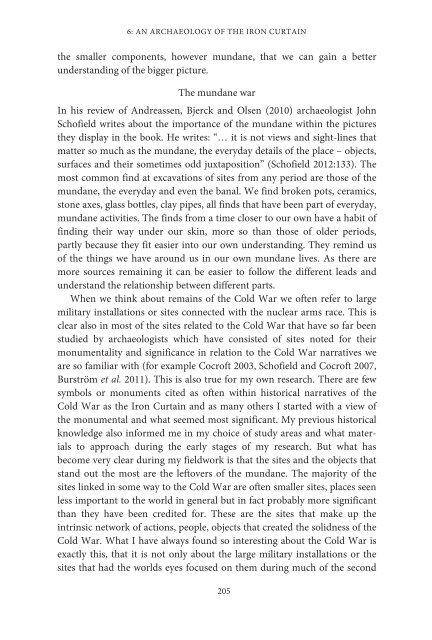1JZGauQ
1JZGauQ
1JZGauQ
Create successful ePaper yourself
Turn your PDF publications into a flip-book with our unique Google optimized e-Paper software.
6: AN ARCHAEOLOGY OF THE IRON CURTAIN<br />
the smaller components, however mundane, that we can gain a better<br />
understanding of the bigger picture.<br />
The mundane war<br />
In his review of Andreassen, Bjerck and Olsen (2010) archaeologist John<br />
Schofield writes about the importance of the mundane within the pictures<br />
they display in the book. He writes: “… it is not views and sight-lines that<br />
matter so much as the mundane, the everyday details of the place – objects,<br />
surfaces and their sometimes odd juxtaposition” (Schofield 2012:133). The<br />
most common find at excavations of sites from any period are those of the<br />
mundane, the everyday and even the banal. We find broken pots, ceramics,<br />
stone axes, glass bottles, clay pipes, all finds that have been part of everyday,<br />
mundane activities. The finds from a time closer to our own have a habit of<br />
finding their way under our skin, more so than those of older periods,<br />
partly because they fit easier into our own understanding. They remind us<br />
of the things we have around us in our own mundane lives. As there are<br />
more sources remaining it can be easier to follow the different leads and<br />
understand the relationship between different parts.<br />
When we think about remains of the Cold War we often refer to large<br />
military installations or sites connected with the nuclear arms race. This is<br />
clear also in most of the sites related to the Cold War that have so far been<br />
studied by archaeologists which have consisted of sites noted for their<br />
monumentality and significance in relation to the Cold War narratives we<br />
are so familiar with (for example Cocroft 2003, Schofield and Cocroft 2007,<br />
Burström et al. 2011). This is also true for my own research. There are few<br />
symbols or monuments cited as often within historical narratives of the<br />
Cold War as the Iron Curtain and as many others I started with a view of<br />
the monumental and what seemed most significant. My previous historical<br />
knowledge also informed me in my choice of study areas and what materials<br />
to approach during the early stages of my research. But what has<br />
become very clear during my fieldwork is that the sites and the objects that<br />
stand out the most are the leftovers of the mundane. The majority of the<br />
sites linked in some way to the Cold War are often smaller sites, places seen<br />
less important to the world in general but in fact probably more significant<br />
than they have been credited for. These are the sites that make up the<br />
intrinsic network of actions, people, objects that created the solidness of the<br />
Cold War. What I have always found so interesting about the Cold War is<br />
exactly this, that it is not only about the large military installations or the<br />
sites that had the worlds eyes focused on them during much of the second<br />
205




